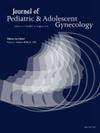月经紊乱对青少年睡眠质量的影响:观察研究
IF 1.7
4区 医学
Q3 OBSTETRICS & GYNECOLOGY
引用次数: 0
摘要
研究目的经前期综合征(PMS)、痛经和异常子宫出血是青春期少女经常遇到的妇科问题。研究表明,睡眠障碍和月经周期不规律是常见的情况,并表明它们可能同时发生。有关睡眠质量与月经之间关系的研究大多针对晚期青少年(17 岁及以上)和青年年龄组。我们的研究旨在评估 12-18 岁青少年的睡眠质量与月经之间的关系:调查研究分为四个部分。第一部分包括人体测量和参与者的病史;第二部分包括 "月经和月经症状史";第三部分包括 "睡眠质量量表和睡眠变量问卷"(SQS-SVQ);第四部分包括 "经前综合征评估量表"(PMSAS)。我们的调查对象是到青春期医学门诊就诊的患者:结果:睡眠质量量表(SQS)得分在 PMSAS 得分高的人群中明显较低(P0.05):根据我们的研究,痛经和经前期综合征可能会对青少年的睡眠质量产生负面影响。与青少年打交道的医务人员应考虑到月经问题对睡眠质量的影响,并提供适当的支持/治疗方案。本文章由计算机程序翻译,如有差异,请以英文原文为准。
The Impact of Menstrual Disorders on Sleep Quality in Adolescents: An Observational Study
Study Objective
Premenstrual syndrome (PMS), dysmenorrhea, and abnormal uterine bleeding are frequent gynecological problems in adolescent girls. Studies show that sleep disorders and menstrual cycle irregularities are common conditions and indicate that they may occur together. Studies on the relationship between sleep quality and menstruation are mostly available for late adolescents (17 years and older) and young adult age groups. Our study aims to evaluate this relationship in adolescents aged 12-18.
Methods
A survey study was structured and consisted of 4 sections. The first section includes anthropometric measurements and medical history of the participants; the second section includes “menstruation and menstruation symptoms history”; the third section includes “The Sleep Quality Scale and Sleep Variable Questionnaire”; and the fourth section includes the “Premenstrual Syndrome Assessment Scale” (PMSAS). Our survey was applied to those who visited the adolescent medicine outpatient clinic.
Results
The Sleep Quality Scale score was significantly lower in those with high PMSAS scores (P < .001). The participants who had dysmenorrhea and experienced other symptoms during menstruation had significantly lower SQS scores and sleep efficiency (SE) (P < .001). There was no significant difference between heavy menstrual bleeding, defined as lasting more than 7 days, requiring more than 5-6 pads/tampons per day, and SE/quality (P > .05).
Conclusion
According to our study, dysmenorrhea and the presence of PMS may negatively affect the sleep quality of adolescents. Health professionals dealing with young people should take into account the effects of menstrual problems on sleep quality and offer appropriate support/treatment options.
求助全文
通过发布文献求助,成功后即可免费获取论文全文。
去求助
来源期刊
CiteScore
3.90
自引率
11.10%
发文量
251
审稿时长
57 days
期刊介绍:
Journal of Pediatric and Adolescent Gynecology includes all aspects of clinical and basic science research in pediatric and adolescent gynecology. The Journal draws on expertise from a variety of disciplines including pediatrics, obstetrics and gynecology, reproduction and gynecology, reproductive and pediatric endocrinology, genetics, and molecular biology.
The Journal of Pediatric and Adolescent Gynecology features original studies, review articles, book and literature reviews, letters to the editor, and communications in brief. It is an essential resource for the libraries of OB/GYN specialists, as well as pediatricians and primary care physicians.

 求助内容:
求助内容: 应助结果提醒方式:
应助结果提醒方式:


